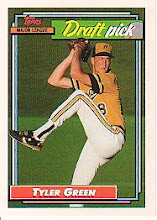
A day after the Phillies decimated the LA Dodgers 10-4 in an anti-climatic NLCS clinching win to propel them to their second consecutive World Series, I've been busy trading dozens of barbs with friends who are die-hard Yankee fans in anticipation of a New York-Philly Series. Only the following text from my college roommate actually made me think:
ROOMIE: Congrats David. Hopefully the yanks handle business tonight. I'm looking forward to exposing lee as the nl fraud he is.
ME: Yeah. 22-3 in the al last yr totally never happened.
ROOMIE: How did he do all years other than that? First half of this year? Just sayin...
You see, Yankee fans think they have one huge (and I mean HUGE) advantage over the Phils in 6-7, 290-pound ace CC Sabathia. To put it more distinctly, they believe the Yankees have a #1 starter and the Phillies do not. With Cole Hamels turning in three totally lackluster starts this postseason after a very average regular season, is Cliff Lee a legitimate #1 starter for the Phightins? Is he the guy who won the 2008 AL Cy Young Award and is currently 2-0 in three postseason starts with a 0.74 ERA in 24 1/3 innings or is he really the pitcher who was so poor in 2007 that he had to be sent down to the minor leagues and is actually just a mediocre AL starter thriving in an inferior league?
First off, let's dismiss the notion that Lee was just an average pitcher in the AL this year before his trade to Philadelphia. Sure his record was just 7-9 in 22 starts, but won-loss record is just about the worst statistical measure out there (aside from only the ridiculous save statistic) in determining a pitchers true worth. At the time of the trade, Lee led the AL with 152 innings pitched and sported a 3.14 ERA - better than Sabathia's 3.37 mark for the season. So now that that silliness can be disregarded, what happened to Lee in 2007 and is the pitcher from 2008-2009 the real deal? As always, numbers don't lie.
Going into 2007, Lee was a really good pitcher. Maybe not #1 caliber, but a solid #2-type starter. In 2005 and 2006, Lee averaged a 16-8 record with a 4.09 ERA over 201 innings pitched. He averaged 9.3 hits, 2.4 walks and 6.1 strikeouts per nine innings pitched. Really solid numbers across the board, especially from a lefthander. Then 2007. After a 5-8, 6.29 ERA year, the Indians left Lee off their postseason roster. He even was demoted to the minors. What the hell happened? Well......not much actually.
In 2007, Lee gave up just one extra hit and one extra walk per game compared to his previous two seasons. This would naturally lead to him having a worse year, but not the epic fail he endured that season. Basically, he was unlucky and one would expect a return to his previous form as a quality lefthanded starter. Now here's the real mystery - how did Lee bounce back to become not only a good starter, but a legitimately great, #1 pitcher?
Lets take a look at Lee's pitching arsenal from 2007 and 2009, courtesy of FanGraphs:
2007: Fastball (89.0 avg velocity, 68.4% of pitches) Slider (79.0 avg velocity, 4.0% of pitches) Cutter (85.3 avg velocity, 4.9% of pitches) Curveball (75.3 avg velocity, 6.8% of pitches) Changeup (82.1 avg velocity, 15.8 % of pitches)
2009: Fastball (91.1 avg velocity, 61.4% of pitches) Slider (81.2 avg velocity, 1.2% of pitches) Cutter (85.9 avg velocity, 12.4% of pitches) Curveball (75.9 avg velocity, 8.3% of pitches) Changeup (84.0 avg velocity, 16.6 % of pitches)
The first difference that jumps out at you is the velocity increase. For his entire career, Lee's fastball averaged around 89 mph. Then, out of nowhere, it spiked to 90.5 in 2008 and 91.1 this year. I really don't have an explanation for the increase in velocity...maybe his form is better, maybe his arm slot has changed, maybe he's on drugs. No idea. But what I do know is that the difference between averaging 91 mph vs 89 mph is enormous. Against the Dodgers in his last start, Lee was pumping 93 and 94 mph fastballs when he needed them to put away batters. He stuck out 10 hitters in eight dominating innings. If he's topping out at 90 or 91 instead of 94, those strikeouts turn into foul balls or balls in play.
The second thing that I notice is the drastic increase in how many cutters Lee throws. In 2007, only 4.9% of his pitches were cutters. This year that figure was 12.4% and anyone who sees Lee pitch live knows he gives batters fits with that sweeping and diving cutter - especially lefthanded hitters. He's basically scraped his slider in favor of the cut fastball and the results are remarkable. Lee gave up 9.5 hits, 0.7 homeruns, 1.7 walks and struck out 7.0 batters per nine innings this year. Those figures are markedly down from the 10.4 hits, 1.6 homeruns and 3.3 walks allowed per game in 2007. The increased command, lower homerun totals and increased velocity have transformed Lee into a world-beater.
It's true that CC Sabathia is a fantastic pitcher and a dynamic force who has been an absolute horse for the Yankees - especially this postseason. And maybe the defending World (Fucking) Champions will struggle to contain the Yankees lineup and succum to their $200 million All-Star Juggernaut of a roster. But do not underestimate the talent and tenacity of this Phillies team. Maybe they have a shaky bullpen. Maybe they live and die with the homerun. But one thing they do have is an ace.

